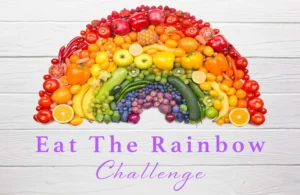Table of Contents
The Ultimate Guide to Eating the Rainbow: A Science-Based Approach to Phytonutrient Diversity
Beyond Colorful Plates: The Deep Science of Phytonutrient Synergy
When we talk about “eating the rainbow,” we’re discussing far more than just making pretty plates. This concept represents one of the most powerful nutritional strategies available, backed by extensive research from institutions like the National Institutes of Health and the World Health Organization.
What Does “Eating the Rainbow” Really Mean?
At its core, eating the rainbow means consuming a diverse array of colorful plant foods daily, with each color representing distinct families of phytonutrients – bioactive compounds that go beyond basic nutrition to provide profound health benefits.

The Science of Eating the Rainbow: A Phytonutrient Guide
What most guides don’t tell you:
- The colors represent different antioxidant profiles
- Each pigment has unique cellular communication functions
- Color diversity correlates with microbiome diversity
- Seasonal color variations provide rotating nutrient benefits
The Hidden Health Benefits of Color Diversity
1. Epigenetic Modulation Through Plant Pigments
Emerging research shows that phytonutrients can actually influence gene expression:
- Anthocyanins (blue/purple foods) upregulate Nrf2 pathway genes
- Carotenoids (orange foods) modulate NF-kB inflammation genes
- Sulforaphane (green crucifers) activates detoxification genes
2. The Gut Microbiome Connection
Each color feeds different beneficial gut bacteria:
| Color | Key Phytonutrient | Beneficial Bacteria Supported |
|---|---|---|
| Red | Lycopene | Lactobacillus |
| Orange | Beta-carotene | Bifidobacterium |
| Green | Chlorophyll | Akkermansia |
| Blue/Purple | Anthocyanins | Faecalibacterium |
3. Longevity and Cellular Repair
Studies of Blue Zones (longevity hotspots) reveal that the most long-lived populations naturally consume the widest spectrum of colorful plants, with measurable impacts on:
- Telomere length maintenance
- Reduced senescent cell accumulation
- Enhanced autophagy processes
The Advanced Rainbow Eating System
Color Mapping: Beyond Basic Categories
Most guides oversimplify the color categories. Here’s a more nuanced approach:
Red Spectrum (600-700nm wavelength pigments)
- True reds: Tomatoes, watermelon (lycopene)
- Red-orange: Paprika, goji berries (capsanthin)
- Red-purple: Pomegranate, blood oranges (anthocyanins)
Green Spectrum (500-600nm)
- Light greens: Cucumber, celery (apigenin)
- Dark greens: Kale, spinach (lutein)
- Blue-greens: Spirulina, chlorella (phycocyanin)
The Phytonutrient Timing Method
New research suggests timing specific colors for optimal effects:
- Morning: Greens and blues (cognitive benefits)
- Afternoon: Reds and oranges (energy support)
- Evening: Purples and whites (relaxation)
Implementing Rainbow Eating: Advanced Strategies
1. The 7-Day Chromatic Cycling Plan
Rather than trying to get every color daily (nearly impossible), rotate focus:
| Day | Color Focus | Sample Foods |
|---|---|---|
| Monday | Red | Tomato soup, watermelon, red bell peppers |
| Tuesday | Orange/Yellow | Sweet potato, mango, yellow squash |
| Wednesday | Green | Kale salad, broccoli, green apples |
| Thursday | Blue/Purple | Blueberry smoothie, purple cabbage |
| Friday | White/Brown | Mushrooms, garlic, jicama |
| Weekend | Rainbow Mix | Variety of all colors |
2. Density Scoring System
Use this point system to maximize phytonutrient intake:
- 1 point: Common varieties (red apples, orange carrots)
- 2 points: Heirloom varieties (purple carrots, black tomatoes)
- 3 points: Wild/foraged foods (wild blueberries, purslane)
Aim for 15+ points daily.
3. Seasonal Color Optimization
Nature provides different colors when we need them most:
- Spring: Greens (detox after winter)
- Summer: Reds/oranges (sun protection)
- Fall: Blues/purples (immunity prep)
- Winter: Whites/browns (gut support)
Frequently Asked Questions
Q: Can I just take phytonutrient supplements instead?
A: Research from the American Journal of Clinical Nutrition shows whole food matrices provide benefits supplements can’t replicate due to the “entourage effect” of thousands of co-occurring compounds.
Q: How do I get all colors in winter?
A: Focus on:
- Frozen berries (blue/purple)
- Citrus fruits (orange)
- Storage crops like beets (red) and squash (orange)
- Fermented foods like sauerkraut (white)
Q: Are white foods really beneficial?
A: Absolutely. White foods like garlic contain allicin, mushrooms contain ergothioneine, and onions contain quercetin – all powerful compounds often overlooked in rainbow eating guides.
Putting It All Together: Your Rainbow Roadmap
- Assess Your Current Palette: Track your colors for 3 days
- Identify Gaps: Which colors are missing?
- Start Small: Add 1 new color daily
- Progress to Rotation: Implement the 7-day chromatic cycle
- Optimize: Incorporate seasonal and heirloom varieties
Remember: Eating the rainbow isn’t about perfection – it’s about progressively expanding your plant pigment diversity for better health outcomes. Even small increases in color variety show measurable benefits in gut microbiome diversity and inflammatory markers.
By moving beyond the basic color categories to understand the deep science behind plant pigments, you can transform your health in ways that go far beyond what standard nutrition guidelines offer. The rainbow isn’t just a pretty visual – it’s a sophisticated biochemical roadmap to optimal wellness.